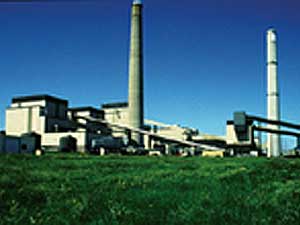|
Audio
Photos
Resources
Your Voice
|
Voluntary mercury pollution plan not working
November 8, 2004
A voluntary effort to cut down on mercury pollution in Minnesota isn't working to keep the toxic metal out of the air. That's the gist of a report from the Izaak Walton League. Most of the airborne mercury in Minnesota comes from coal-fired power plants. The utility industry says it needs more time to develop controls that work.
Duluth, Minn. — The Environmental Protection Agency says one child in six born in the U.S. could be at risk for developmental disabilities after being exposed to mercury in the mother's womb. The mercury comes mostly from the mother eating fish.
Mercury is released into the air from coal-fired power plants and other industries. When it's deposited in lakes and rivers, a toxic form can accumulate in fish. When people eat the fish, the mercury can affect development of the nervous system, causing learning disabilities and problems with attention and memory.
Seven years ago, the Minnesota Pollution Control Agency asked industry and environmental groups for proposals to reduce airborne mercury levels. Industry representatives wanted to try a voluntary approach. The Izaak Walton League's Sarah Welch says that approach didn't work.
"Industry made it pretty clear they did not want to have uniform reporting requirements," Welch says. "'There should be no state mandates, and no industry should be forced to develop a voluntary agreement.'"
|
A power plant is a very large, complex system ... and as you start sticking things on the back end, or the front end, you just have to make sure you're not goofing up something else.
- Lee Eberley, air quality manager for Xcel Energy |
Companies that produce airborne mercury each came up with their own plan to reduce mercury. Most did get rid of a lot of mercury in their plants. They replaced thermostats and other equipment with non-mercury models. And they set up recycling programs for things like fluorescent light bulbs.
But those products don't usually send mercury into the air. Most of the airborne mercury comes from coal-fired power plants. And that amount has actually increased over the last seven years.
One plant alone -- Xcel Energy's Sherco plant in Sherburne County -- accounts for about one-quarter of the airborne mercury in the state. It serves more than two million homes.
Xcel is researching ways to control mercury. But it's complicated because each plant uses a different mix of coal types, and different processes. So there's no off-the-shelf system that will work at all plants.
So far the most promising technology is activated carbon injection. Powdered activated carbon binds with mercury, which can then be captured by existing pollution control devices. The Izaak Walton League estimates this method can capture between 60 and 90 percent of mercury.
Lee Eberley, air quality manager for Xcel, says Xcel needs to be sure pollution controls won't interfere with the efficient operation of the plant.
"A power plant is a very large, complex system, and all the gears have to mesh for that thing to run right and to produce power we all rely on," Eberly says. "And as you start sticking things on the back end, or the front end, you just have to make sure you're not goofing up something else, to put it quite simply."
Xcel is converting two power plants in the Twin Cities area to natural gas, which has virtually no mercury emissions. State law allows the utility to increase rates to pay off the conversion cost without going through the standard rate increase approval process.
Xcel says the conversion will cost the average household only about $3 more a month. But Xcel doesn't want to convert the Sherco plant to natural gas, because it doesn't want to become too dependent on one type of fuel.
The other main source of mercury in the air in Minnesota is the smokestacks at taconite operations. Capturing mercury emissions there will be even harder than at power plants.
Most mercury from smokestacks is carried long distances. So environmental groups and utilities agree the problem calls for national, or even international, efforts.
The Bush administration is proposing an emissions-trading program similar to the one in place for acid rain pollution. But the MPCA's David Thornton says that would allow continued "hot spots" of mercury contamination.
"We wouldn't want completely open trading -- that would result in moving all of the reductions, for example, to power plants in the Ohio River Valley," Thornton says. "That would mean that we would get very little benefit here in Minnesota."
Several New England states and Wisconsin have recently passed strict mercury control laws.
The Izaak Walton League says Minnesota's voluntary program isn't working. The group says if the federal rule isn't tightened, Minnesota should consider legislation requiring mercury reductions.
|
News Headlines
|
Related Subjects
|

